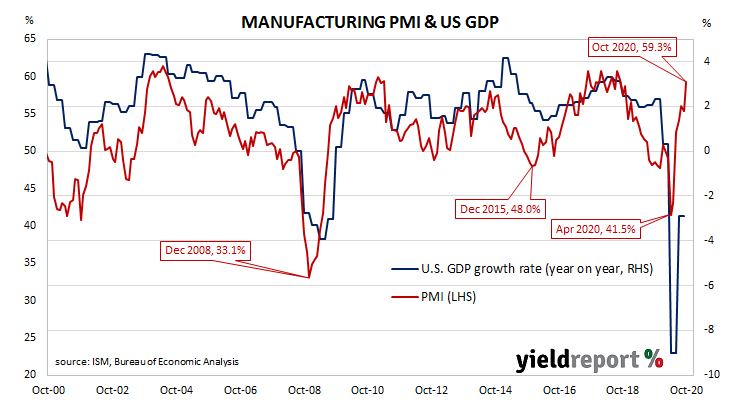Summary: ISM purchasing managers index (PMI) up; reading well above consensus expectation; “strong momentum at the start of Q4”; reading implies US economy growing at solid pace.
US purchasing managers’ index (PMI) readings reached a cyclical peak in September 2017 before they started a downtrend which stabilised in late 2019 after a truce of sorts was made with the Chinese regarding trade. March’s report signalled a contraction in US manufacturing activity had begun; it stayed in this state until June.
According to the latest Institute of Supply Management (ISM) survey, its Purchasing Managers Index recorded a reading of 59.3% in October. The result was well above the expected figure of 55.6% and higher than September’s reading of 55.4%. The average reading since 1948 is 52.9% and any reading above 50% implies an expansion in the manufacturing sector. A reading “above 42.8%, over a period of time, generally indicates an expansion of the overall economy,” according to the ISM.
ANZ senior economist Felicity Emmett said the rise pointed “to strong momentum at the start of Q4.”

US Treasury bond yields reacted in a mixed fashion on the day. By the close of business, the 2-year Treasury bond yield had slipped 1bp to 0.16%, the 10-year yield had shed 2bps to 0.86% but the 30-year yield finished 6bps higher at 1.66%.
Purchasing Managers’ Indices (PMIs) are economic indicators derived from monthly surveys of executives in private-sector companies. They are diffusion indices, which means a reading of 50% represents no change from the previous period, while a reading under 50% implies respondents reported a deterioration on average. They are particularly useful as a leading indicator.
Manufacturing PMI figures appear to lead US GDP by several months despite a considerable error in any given month. The chart below shows US GDP on a “year on year” basis (and not the BEA annualised basis) against US GDP implied by monthly PMI figures.

